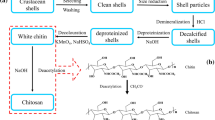Abstract
Carbon-coated Fe3O4 (Fe3O4/C) microspheres activated with 1-ethyl-3-(3-dimethylaminopropyl)-carbodiimide hydrochloride (EDC) were prepared, characterized and applied to adsorb bovine serum albumin (BSA). The prepared magnetic microspheres had spherical core-shell structure with a uniform and continuous carbon coating coupled with activation by EDC, and possessed superparamagnetic characteristics. The experimental results showed that the adsorption amount of BSA on the EDC-activated Fe3O4/C (Fe3O4/C-EDC) microspheres was higher than that on the Fe3O4/C microspheres. The maximum adsorption of BSA on Fe3O4/C-EDC microspheres occurred at pH 4.7, which was the isoelectric point of BSA. At low concentrations (below 1.0 M), salt had no noticeable effect on BSA adsorption. The BSA adsorption of Fe3O4/C-EDC microspheres had a better fit to the Langmuir model than the Freundlich isotherm and Temkin isotherm model, and the kinetic data were well described by the pseudo-second-order model. The adsorption equilibrium could be reached within 20 min. High desorption efficiency (97.6%) of BSA from Fe3O4/C-EDC microspheres was obtained with 0.5 M Na2HPO4 (pH 9.4) as the desorbent.
Similar content being viewed by others
References
Mou F Z, Guan J G, Xiao Z D, et al. Solvent-mediated Synthesis of Magnetic Fe2O3 Chestnut-like Amorphous-core/gamma-phase-shell Hierarchical Nanostructures with Strong As(V) Removal Capability[J]. Mater. Chem., 2011, 21(14): 5414–5421
Shao D D, Xu K K, Song X J, et al. Effective Adsorption and Separation of Lysozyme with PAA-modified Fe3O4@silica core/shell Microspheres[J]. Colloid Interface Sci., 2009, 336(2): 526–532
Wang L S, Kim C H, Zhang Z F, et al. Adsorption Behavior of Lysozyme on Carbon-coated Fe3O4 Nanoparticles[J]. Curr. Nanosci., 2017, 13(2): 159–166
Xia T T, Guan Y P, Yang M Z, et al. Synthesis of Polyethylenimine Modified Fe3O4 Nanoparticles with Immobilized Cu2+ for Highly Efficient Proteins Adsorption[J]. Colloid Surface. A, 2014, 443: 552–559
Zhang S X, Niu H Y, Hu Z J, et al. Preparation of Carbon Coated Fe3O4 Nanoparticles and Their Application for Solid-phase Extraction of Polycyclic Aromatic Hydrocarbons from Environmental Water Samples[J]. J. Chromatogr. A, 2010, 1217(29): 4757–4764
Yang J, Li J Y, Qiao J Q, et al. Solid Phase Extraction of Magnetic Carbon Doped Fe3O4 Nanoparticles[J]. J. Chromatogr.. A, 2014, 1325: 8–15
Yang J, Li J Y, Qiao J Q, et al. Magnetic Solid Phase Extraction of Brominated Flame Retardants and Pentachlorophenol from Environmental Waters with Carbon Doped Fe3O4 Nanoparticles[J]. Appl. Surface Sci., 2014, 321: 126–135
Shen R, Yang F, Wang J, et al. Application of Magnetic Material in the Determination of Polycyclic Aromatic Hydrocarbons in Tree Leaves by High Performance Liquid Chromatography[J]. Anal. Method., 2011, 3(12): 2909–2914
Heidari H, Razmi H. Multi-response Optimization of Magnetic Solid Phase Extraction Based on Carbon Coated Fe3O4 Nanoparticles Using Desirability Function Approach for the Determination of the Organophosphorus Pesticides in Aquatic Samples by HPLC-UV[J]. Talanta, 2012, 99: 13–21
Bao X L, Qiang Z M, Chang J H, et al. Synthesis of Carbon-coated Magnetic Nanocomposite (Fe3O4@C) and Its Application for Sulfonamide Antibiotics Removal from Water[J]. Environ. Sci., 2014, 26(5): 962–969
Zhang Z Y, Kong J L. Novel Magnetic Fe3O4@C Nanoparticles as Adsorbents for Removal of Organic Dyes from Aqueous Solution[J]. J. Hazard. Mater., 2011, 193: 325–329
Chen J P, Chen Y C. Preparations of Immobilized Lysozyme with Reversibly Soluble Polymer for Hydrolysis of Microbial Cells[J]. Bioresource Technol., 1997, 60(3): 231–237
Dilgimen A S, Mustafaeva Z, Demchenko M, et al. Water-soluble Covalent Conjugates of Bovine Serum Albumin with Anionic Poly (N-isopropyl-acrylamide) and Their Immunogenicity[J]. Biomater., 2001, 22(17): 2383–2392
Koneracka M, Kopcansky P, Antalik M, et al. Immobilization of Proteins and Enzymes to Fine Magnetic Particles[J]. Magn. Mater., 1999, 201: 427–430
Peng Z G, Hidajat K, Uddin M S. Conformational Change of Adsorbed and Desorbed Bovine Serum Albumin on Nano-sized Magnetic Particles[J]. Colloid. Surface. B, 2004, 33(1):15–21
Deng H, Li X, Peng Q, et al. Monodisperse Magnetic Single-crystal Ferrite Microspheres[J]. Angew. Chem. Int. Ed., 2005, 44(18): 2782–2785
Tang H J, Han T T, Luo Z J, et al. Magnetite/N-doped Carboxylate-rich Carbon Spheres: Synthesis, Characterization and Visible-light-induce Photocatalytic Properties[J]. Chin. Chem. Lett., 2013, 24(1): 63–66
Peng Z G, Hidajat K, Uddin M S. Adsorption of Bovine Serum Albumin on Nanosized Magnetic Particles[J]. J. Colloid Interface. Sci., 2004, 271(2): 277–283
Liu H S, Wang Y C, Chen W Y. The Sorption of Lysozyme and Ribonuclease onto Ferromagnetic Nickel Powder. 1. Adsorption of Single Components[J]. Colloid. Surface B, 1995, 5(1-2): 25–34
Li Z H, Cao M, Zhang W G, et al. Affinity Adsorption of Lysozyme with Reactive Red 120 Modified Magnetic Chitosan Microspheres[J]. Food Chem., 2014, 145: 749–755
Sun J, Su Y J, Rao S Q, et al. Separation of Lysozyme Using Superparamagnetic Carboxymethyl Chitosan Nanoparticles[J]. J. Chromatogr. B, 2011, 879(23): 2194–2200
Lawal O S, Sanni A R, Ajayi I A, et al. Equilibrium, Thermodynamic and Kinetic Studies for the Biosorption of Aqueous Lead(II) Ions onto the Seed Husk of Calophyllum Inophyllum[J]. J. Hazard. Mater., 2010, 177(1-3): 829–835
Shamim N, Hong L, Hidajat K, et al. Thermosensitive Polymer Coated Nanomagnetic Particles for Separation of Bio-molecules[J]. Sep. Purif. Technol., 2007, 53(2): 164–170
Author information
Authors and Affiliations
Corresponding author
Additional information
Funded by the Major Science and Technology Program for Water Pollution Control and Treatment (No. 2013ZX07202-010)
Rights and permissions
About this article
Cite this article
Shan, J., Kim, C., Zhang, Z. et al. Adsorption of BSA on carbon-coated Fe3O4 microspheres activated with 1-ethyl-3-(3-dimethylaminopropyl)-carbodiimide hydrochloride. J. Wuhan Univ. Technol.-Mat. Sci. Edit. 33, 1–8 (2018). https://doi.org/10.1007/s11595-018-1777-0
Received:
Accepted:
Published:
Issue Date:
DOI: https://doi.org/10.1007/s11595-018-1777-0




